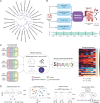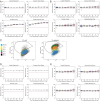Phenotype-Based Threat Assessment
- PMID: 35363569
- PMCID: PMC9168455
- DOI: 10.1073/pnas.2112886119
Phenotype-Based Threat Assessment
Abstract
Bacterial pathogen identification, which is critical for human health, has historically relied on culturing organisms from clinical specimens. More recently, the application of machine learning (ML) to whole-genome sequences (WGSs) has facilitated pathogen identification. However, relying solely on genetic information to identify emerging or new pathogens is fundamentally constrained, especially if novel virulence factors exist. In addition, even WGSs with ML pipelines are unable to discern phenotypes associated with cryptic genetic loci linked to virulence. Here, we set out to determine if ML using phenotypic hallmarks of pathogenesis could assess potential pathogenic threat without using any sequence-based analysis. This approach successfully classified potential pathogenetic threat associated with previously machine-observed and unobserved bacteria with 99% and 85% accuracy, respectively. This work establishes a phenotype-based pipeline for potential pathogenic threat assessment, which we term PathEngine, and offers strategies for the identification of bacterial pathogens.
Keywords: adherence; bacterial pathogen; machine learning; threat assessment; toxicity.
Conflict of interest statement
The authors declare no competing interest.
Figures





References
-
- Hosainzadegan H., Khalilov R., Gholizadeh P., The necessity to revise Koch’s postulates and its application to infectious and non-infectious diseases: A mini-review. Eur. J. Clin. Microbiol. Infect. Dis. 39, 215–218 (2020). - PubMed
-
- Bartoszewicz J. M., Seidel A., Rentzsch R., Renard B. Y., DeePaC: Predicting pathogenic potential of novel DNA with reverse-complement neural networks. Bioinformatics 36, 81–89 (2020). - PubMed
-
- Zhao X., Wang N., An interpretable machine learning method for detecting novel pathogens. Res. Sq. [Preprint] (2020). https://www.researchsquare.com/article/rs-11084/v2. Accessed 16 March 2020.
MeSH terms
Substances
LinkOut - more resources
Full Text Sources

